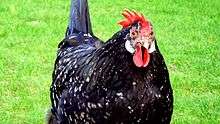Ancona chicken
The Ancona is a breed of chicken which originated in the Marche region of Italy, but which was bred to its present type mainly in the United Kingdom in the nineteenth century. It is named after the city of Ancona, capital of the Marche. It is popular in Britain and the United States, but uncommon in Italy; an initiative to re-establish it in its native area and preserve its biodiversity was launched in 2000.[3] There are also Ancona bantams.
 | |
| Country of origin | Italy; United Kingdom |
|---|---|
| Use | eggs |
| Traits | |
| Weight |
|
| Skin color | Yellow |
| Egg color | White |
| Comb type | Single or rose |
| Classification | |
| APA | Mediterranean[1] |
| PCGB | Soft feather: light[2] |
| |
History
The Ancona originated in central Italy,[4] where it was the most widely distributed breed of chicken.[5] The first Ancona chickens were imported into England in 1851,[6] and selectively bred there for regularity and consistency of the white markings in the plumage. In 1880 a breeder named Cobb showed a group. Some birds were exported from Britain to the United States in 1888. Rose-combed Ancona chickens were first shown in Birmingham in 1910.[5]
In the United States, the single-comb Ancona was recognised by the American Poultry Association in 1898, and the rose-comb bird in 1914.[1][7]
Characteristics
The Ancona is a typical Mediterranean breed, rustic, lively and hardy.[4] Birds range widely and take flight easily.[7]
The plumage is black, mottled with white. Approximately one feather in three has a v-shaped white marking at the tip. All primaries, sickles and tail-feathers should have white tips. The black feathers may have a beetle-green tint. In Italy, blue mottled with white is also recognised in full-size birds, but not in bantams. Australia recognises a Red variety, with a chestnut to red bay ground colour.[8]
The legs are yellow mottled with black, the beak yellow with some black markings on the upper mandible, and the eye orange-red. The skin is yellow, the ear-lobes white or cream-coloured. The comb is of medium size, with five well-marked points; in hens it should fall gracefully to one side.[4] In the United Kingdom and in the United States, but not in Italy, a rose comb is permitted.[7]
Cocks weigh 2.5 to 2.8 kg (5.5 to 6.2 lb) and hens 1.8 to 2.1 kg (4.0 to 4.6 lb);[4] ring sizes are 18 mm and 16 mm respectively for full-sized birds, and 13 mm and 11 mm for bantams.[9]
Use
The Ancona is a good layer of white eggs, of which it lays an average of 220 per year;[6] the eggs weigh 50 g or more.[4] Hens have little tendency to broodiness; pullets may begin to lay at 5 months.
References
- APA Recognized Breeds and Varieties: As of January 1, 2012. American Poultry Association. Archived 4 November 2017.
- Breed Classification. Poultry Club of Great Britain. Archived 12 June 2018.
- Pollo Ancona: biodiversità e animali da fattoria (in Italian). Associazione Civiltà Contadina per la salvaguardia della biodiversità rurale. Archived 3 February 2012.
- Ancona (in Italian). Atlante delle razze di Polli - Razze italiane. Accessed June 2013.
- Alessio Zanon (2003–2012). Ancona (in Italian). Il Pollaio del Re. Archived 3 July 2012.
- Breed data sheet: Ancona/Italy. Domestic Animal Diversity Information System of the Food and Agriculture Organization of the United Nations. Accessed August 2014.
- Ancona Chicken. American Livestock Breeds Conservancy, 1993–2009. Archived 10 April 2013.
- Limited, Victorian Poultry Fanciers Association (2011). Australian poultry standards (2nd ed.). Ballarat, Vic.: Victorian Poultry Fanciers Association Limited. pp. 26–27. ISBN 9781921488238.
- Elenco delle razze riconosciute dallo Standard Italiano: anelli di riconoscimento e colorazioni ufficiali (in Italian). Federazione Italiana Associazioni Avicole. Archived 27 June 2013.